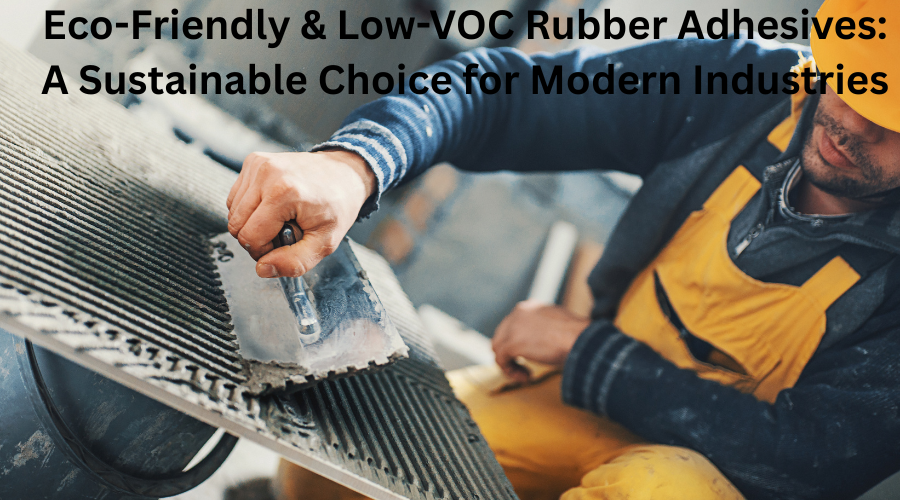Eco-Friendly & Low-VOC Rubber Adhesives: A Sustainable Choice for Modern Industries
- qinglongdatech
- Aug 11
- 4 min read

In today’s manufacturing landscape, there’s a growing demand for materials and products that not only perform well but also minimize environmental impact. One area seeing significant innovation is in rubber adhesives—specifically, eco-friendly and low-VOC options. Whether you’re a product manufacturer, an industrial buyer, or a rubber adhesive supplier, understanding the advantages of these sustainable solutions can help you stay ahead of market trends while supporting environmental responsibility.
What Are Eco-Friendly & Low-VOC Rubber Adhesives?
Eco-friendly rubber adhesives are formulated with sustainability in mind. Instead of relying on high levels of volatile organic compounds (VOCs)—which can add to atmospheric contamination and health hazards—low-VOC adhesives use alternative chemistries that reduce harmful emissions.
VOCs are carbon-based chemicals that easily vaporize at room temperature, often found in traditional adhesives, paints, and solvents. Reducing VOC content means cleaner air, safer work environments, and a smaller environmental footprint.
Why Industries Are Shifting Toward Low-VOC Adhesives
The shift toward low-VOC and eco-friendly adhesives isn’t just a passing trend—it’s being driven by regulatory requirements, corporate sustainability goals, and consumer demand. Some key reasons include:
Compliance with Environmental Regulations – Many countries are enforcing stricter VOC limits in manufacturing processes.
Workplace Safety – Reduced chemical exposure improves the safety and well-being of workers.
Brand Image & Marketability – Companies can appeal to environmentally conscious consumers.
Long-Term Cost Efficiency – Eco-friendly formulations often improve durability and reduce waste.
Key Benefits of Eco-Friendly Rubber Adhesives
1. Healthier Work Environments
Traditional adhesives can release strong fumes that require heavy ventilation systems. Low-VOC versions minimize toxic emissions, making workplaces safer for employees.
2. Reduced Environmental Impact
Eco-friendly adhesives use renewable or less harmful raw materials, which means less environmental degradation during production and disposal.
3. Improved Product Performance
Advances in green chemistry mean that sustainable adhesives can now equal or surpass the performance of traditional adhesives in terms of strength, flexibility, and durability.
4. Versatility in Applications
From automotive interiors to footwear manufacturing, eco-friendly adhesives are compatible with multiple substrates including rubber, metal, and textiles.
Common Applications of Low-VOC Rubber Adhesives
Eco-friendly rubber adhesives are used across a variety of industries, including:
Automotive Manufacturing – For bonding seals, gaskets, and insulation without harmful fumes.
Footwear Industry – For attaching soles to uppers while reducing VOC exposure for workers.
Construction & Flooring – To bond rubber mats, underlays, and safety surfaces.
Packaging & Consumer Goods – For products that need safe and clean bonding methods.
Choosing the Right Eco-Friendly Rubber Adhesive
When selecting a low-VOC rubber adhesive, consider:
Bonding Strength Requirements – Different adhesives have varying tensile and peel strengths.
Application Method – Spray, brush, or automated dispensing.
Curing Time – Faster curing can improve production speed.
Temperature & Chemical Resistance – Especially important for industrial applications.
Regulatory Certifications – Look for compliance with LEED, GreenGuard, or ISO environmental standards.

The Role of Innovation in Green Adhesives
The adhesive industry is seeing rapid technological advancements. Today’s eco-friendly rubber adhesives often feature:
Water-Based Formulations – Significantly lower VOC levels compared to solvent-based adhesives.
Bio-Based Ingredients – Derived from renewable plant-based sources instead of petroleum.
Smart Additives – Enhance performance while maintaining sustainability.
Manufacturers are also investing in recyclable adhesive technologies to further reduce environmental waste.
How to Transition to Eco-Friendly Adhesives in Your Business
Switching to eco-friendly adhesives can seem daunting, but with the right strategy, it’s achievable:
Audit Current Adhesive Usage – Identify where high-VOC products are still being used.
Work with Trusted Suppliers – Partner with those who have proven expertise in sustainable adhesives.
Test & Validate – Ensure the green alternative meets your performance standards before full adoption.
Train Your Workforce – Educate staff on handling, application, and storage best practices.
Challenges in Adopting Low-VOC Rubber Adhesives
While the benefits are clear, businesses may face:
Initial Cost Concerns – Some eco-friendly options have higher upfront prices (though costs may balance out over time).
Performance Perception – Older green adhesives had performance limitations, but modern ones are far more advanced.
Supply Chain Availability – Certain specialized adhesives may have longer lead times.
Overcoming these challenges involves supplier collaboration, product testing, and long-term planning.
Future of Eco-Friendly Rubber Adhesives
As environmental regulations tighten and green manufacturing becomes a global priority, eco-friendly and low-VOC adhesives will likely become the industry standard. Nanotechnology, bioengineering, and advanced polymer science will continue to improve both the performance and sustainability of these products.
Companies that adopt these adhesives early position themselves as leaders in environmental responsibility while gaining a competitive edge in the marketplace.
Conclusion
The move toward eco-friendly and low-VOC rubber adhesives represents more than just a regulatory shift—it’s a strategic decision that benefits businesses, workers, consumers, and the planet. By partnering with knowledgeable suppliers and embracing innovative, sustainable products, industries can ensure they’re ready for a greener future. In short, these adhesives are not just good for the environment—they’re good for business.
FAQs
1. What does VOC mean in adhesives?
VOC represents Volatile Organic Compounds, chemicals that can easily vaporize and cause air pollution and health risks.
2. Are low-VOC adhesives weaker than traditional ones?
No. Modern low-VOC adhesives are engineered to offer the same or better bonding performance as conventional adhesives.
3. Can eco-friendly adhesives be used in high-temperature applications?
Yes, many are designed with heat-resistant properties suitable for demanding environments.
4. Do eco-friendly adhesives cost more?
Some may have a slightly higher initial cost, but they often deliver long-term savings through efficiency and regulatory compliance.
5. How can I source a reputable supplier for eco-friendly adhesives?
Look for suppliers with proven expertise, certifications, and a strong track record in sustainable adhesive solutions.







Comments